This fall The Phillips Collection takes a fresh look at the artistic process of Vincent van Gogh (1853–1890). While recognized for the intensity and speed with which he painted, van Gogh also could work with careful deliberation, creating numerous versions of some of his most famous subjects. The first exhibition in Phillips Collection history devoted to the artist, Van Gogh Repetitions goes beneath the surface of some of his best-known paintings to examine how and why he repeated certain compositions during his 10-year career. More than 30 paintings and works on paper are on view at The Phillips Collection from Oct. 12, 2013, through Jan. 26, 2014.
The exhibition is the first to focus on van Gogh’s “repetitions”—a term the artist used to describe his practice of creating more than one version of a particular subject. He often began by sketching a person or landscape rapidly from life. Back in the studio, he would repeat the subject, reworking and refining his idea on a fresh canvas, in some cases many times. In contrast to the popular perception of van Gogh wielding his brush with wild abandon before nature, Repetitions shows how the artist was also methodical and controlled.
“This is a rare opportunity to get to know one of the world’s most recognizable artists in a fresh, new way,” said Dorothy Kosinski, director of The Phillips Collection. “He is such a beloved figure who has earned great renown, but there is still much more to be learned. Through a close examination of this fascinating but only partially understood aspect of his work, we can create a richer, more meaningful picture of his personal life and artistic production.”

Vincent van Gogh, The Large Plane Trees (Road Menders at Saint-Rémy), 1889. Oil on fabric, 28 7/8 x 36 1/8 in. The Cleveland Museum of Art, Gift of the Hanna Fund, 1947.
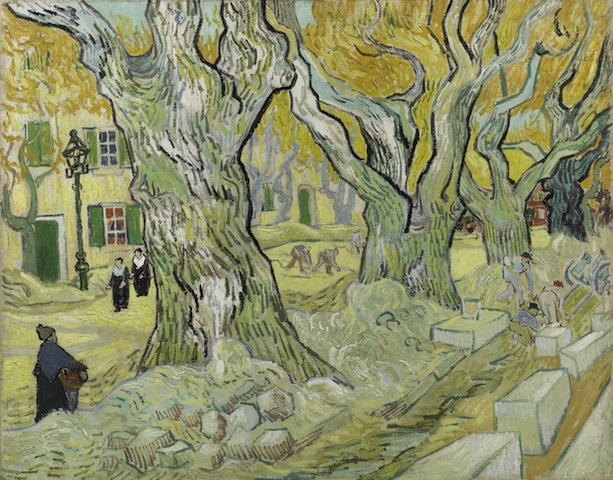
Vincent van Gogh, The Road Menders, 1889. Oil on canvas, 29 x 36 ½ in. The Phillips Collection, Washington, DC. Acquired 1949.
Van Gogh Repetitions is inspired by The Road Menders (1889) in The Phillips Collection and a painting of the same subject, The Large Plane Trees (1889), in The Cleveland Museum of Art. The exhibition reunites the two masterpieces—never before seen together in Washington—and invites deep, focused study of the similarities and differences between them, revealing some surprising facts about van Gogh’s process and motivation.
ANALYSIS REVEALS THE ARTIST’S PROCESS
Examples from 13 of van Gogh’s repetitions will be on view, in some cases reunited for the first time in many years. The exhibition reveals the vitality and persistence of this method across van Gogh’s career in significant locales in the Netherlands and in France, including Paris, Arles, Saint-Rémy, and Auvers. It brings together portraits and landscapes from some of the world’s most renowned collections, including The Metropolitan Museum of Art and The Museum of Modern Art, New York; Museum of Fine Arts, Boston; Philadelphia Museum of Art; The Art Institute of Chicago; Kröller-Müller Museum, Otterlo; and the Van Gogh Museum, Amsterdam. The exhibition offers an exceptional opportunity to see masterpieces from the Musée d’Orsay, Paris, including

Vincent van Gogh, The Bedroom at Arles, 1889. Oil on canvas, 22 11/16 x 29 1/8 in. Musée d’Orsay, Paris. © RMN-Grand Palais / Hervé Lewandowski / Art Resource, NY

and L’Arlésienne (1888).
VAN GOGH AND THE PHILLIPS COLLECTION
Museum Founder Duncan Phillips first expressed his desire to acquire “examples of the inventive genius of van Gogh” in 1926. In 1930,
.jpg!Large.jpg)
Vincent van Gogh, Entrance to the Public Gardens in Arles, 1888. Oil on canvas 28 1/2 x 35 3/4 in. The Phillips Collection, Washington, DC. Acquired 1930 (
—one of the first paintings by van Gogh in an American museum—entered the collection.
In 1949, Phillips acquired The Road Menders (1889) , which he ranked “among the best van Goghs,” and in 1952 added

House at Auvers (1890).
Phillips also purchased two van Gogh works on paper:

an etching of Dr. Gachet (1890)
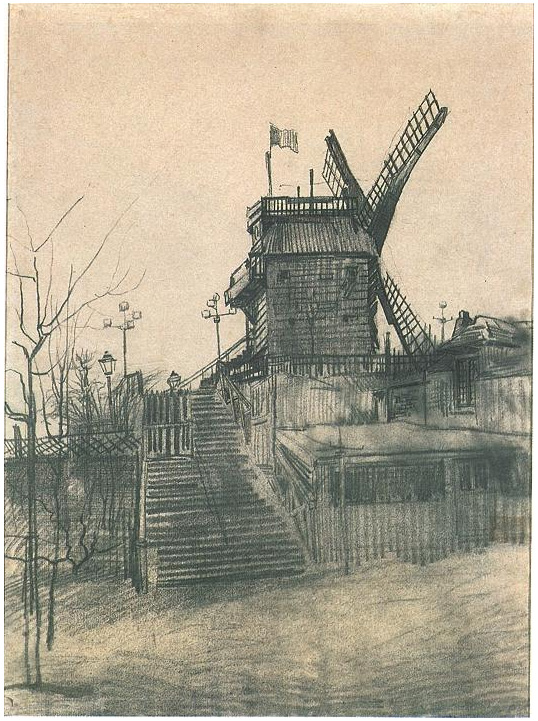
and a pencil and ink drawing of Moulin de la Galette (1887).
CATALOGUE

A beautiful and groundbreaking catalogue, published by Yale University Press in association with The Phillips Collection and The Cleveland Museum of Art, accompanies the exhibition. It features 125 color illustrations, including numerous examples of Vincent van Gogh’s repetitions along with related works and technical studies. Essays by Phillips Chief Curator Eliza Rathbone and Cleveland Curator of Modern European Art William Robinson consider the many unresolved issues and controversies surrounding van Gogh’s repetitions, exploring their origins, development, and meaning in van Gogh’s art. Analyses of specific paintings by Rathbone, Robinson, Phillips Head of Conservation Elizabeth Steele, and Cleveland Paintings Conservator Marcia Steele make use of technical and analytical examinations to understand how the artist worked.
ORGANIZATION
Van Gogh Repetitions is co-organized by The Phillips Collection, Washington, DC, and The Cleveland Museum of Art, Cleveland, Ohio. After opening at The Phillips Collection, it travels to The Cleveland Museum of Art where it is on view March 2 through May 26, 2014.
More info and images on multiples here
More images:

Vincent van Gogh, Weaver, 1884. Oil on canvas, 24 5/8 x 33 1/4 in. Museum of Fine Arts, Boston, Tompkins Collection—Arthur Gordon Tomkins Fund

Vincent van Gogh, Le Moulin de la Galette, 1886. Oil on canvas, 15 x 18 1/4 in. Nationalgalerie, Staatliche Museen, Berlin, Germany
%20by%20Vincent%20Van%20Gogh.jpg)
Vincent van Gogh, Portrait of Camille Roulin, 1888. Oil on canvas, 16 x 12 3/4 in. Van Gogh Museum, Amsterdam

Vincent van Gogh, Portrait of Marcelle Roulin, 1888. Oil on canvas, 13 3/4 x 9 3/4 in. Van Gogh Museum, Amsterdam
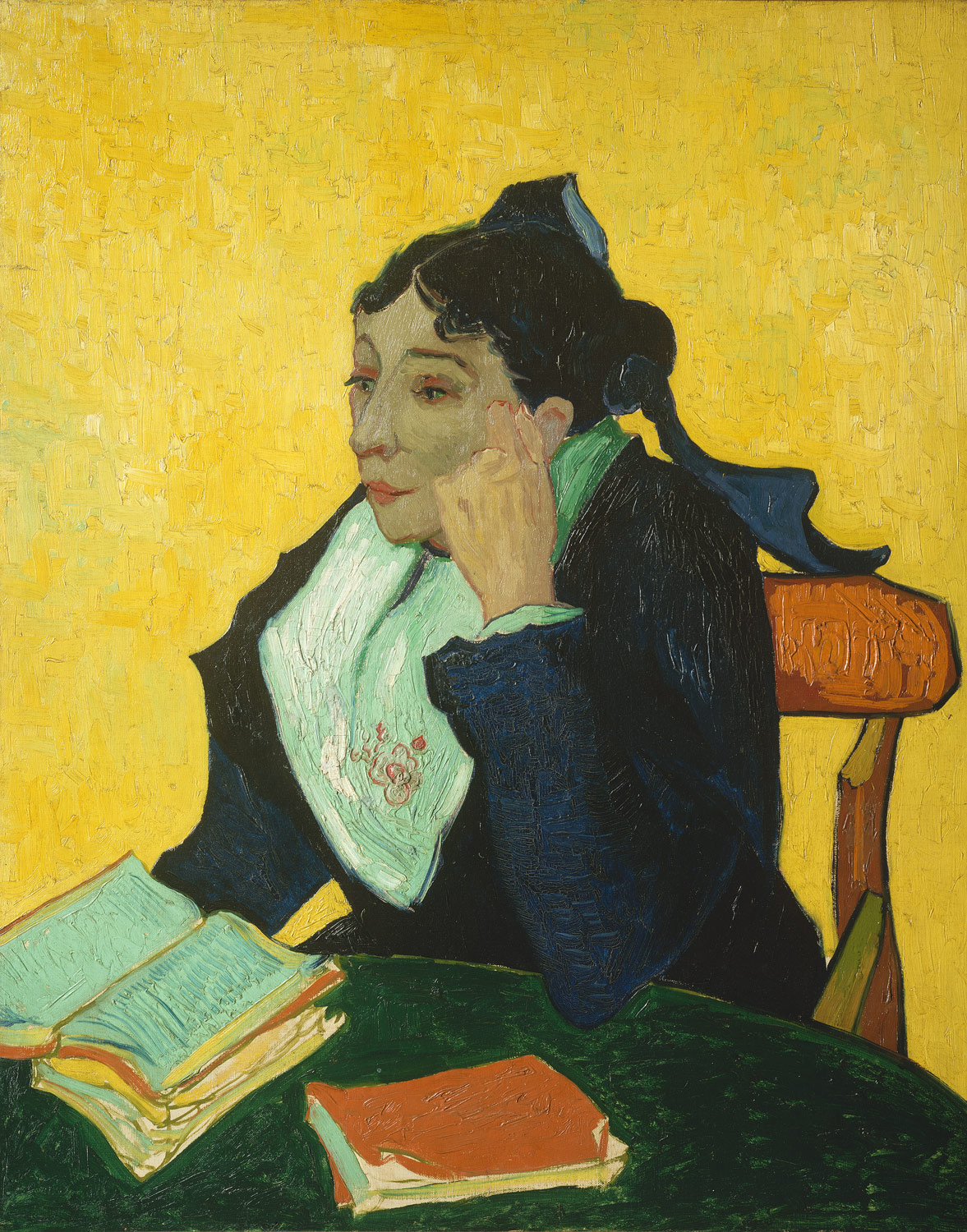
Vincent van Gogh, L'Arlésienne (Madame Joseph-Michel Ginoux), 1888–89. Oil on canvas, 36 x 29 in. The Metropolitan Museum of Art, New York. Bequest of Sam A. Lewisohn, 1951
_van_Gogh_Kroller.jpg/490px-Portrait_of_the_Postman_Joseph_Roulin_(1889)_van_Gogh_Kroller.jpg)
Vincent van Gogh, The Postman Joseph Roulin, February–March 1889. Oil on canvas, 25 5/8 x 21 1/4 in. Collection Kröller-Müller Museum, Otterlo

Vincent van Gogh, Portrait of Joseph Roulin, 1889. Oil on canvas, 25 3/8 x 21 3/4 in. The Museum of Modern Art, New York. Gift of Mr. and Mrs. William A. M. Burden, Mr. and Mrs. Paul Rosenberg, Nelson A. Rockefeller, Mr. and Mrs. Armand P. Bartos, The Sidney and Harriet Janis Collection, Mr. and Mrs. Werner E. Josten, and Loula D. Lasker Bequest (all by exchange). Digital Image © The Museum of Modern Art /Licensed by SCALA / Art Resource, NY

Vincent van Gogh, Madame Roulin Rocking the Cradle (La Berceuse), 1889. Oil on canvas, 36 1/2 x 29 1/2 in. Helen Birch Bartlett Memorial Collection. The Art Institute of Chicago
Vincent van Gogh, Lullaby: Madame Augustine Roulin Rocking a Cradle (La Berceuse), 1889. Oil on canvas, 36 1/2 x 28 5/8 in. Museum of Fine Arts, Boston. Bequest of John T. Spaulding
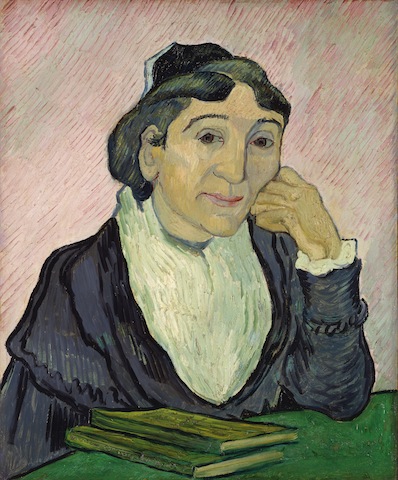
Vincent van Gogh, L’Arlesienne, 1890. Oil on canvas, 23 5/16 x 19 3/4 in. Rome, National Gallery of Modern Art. By permission of Ministero dei Beni, delle Attività Culturali e del Turismo
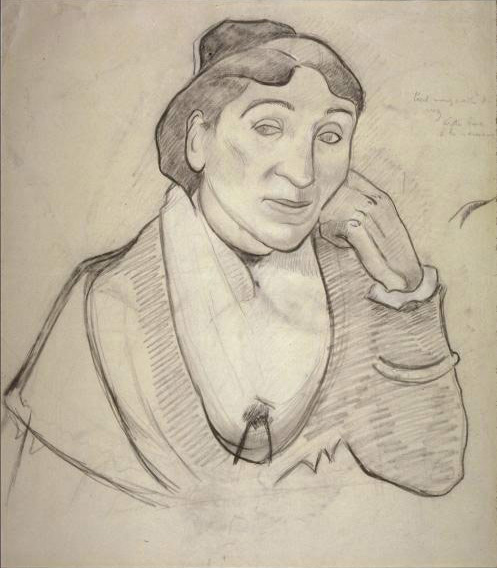
Paul Gauguin, L'Arlesienne, Mme. Ginoux (The Woman from Arles, Madame Ginoux), 1888. Colored chalks and charcoal with white chalk on wove paper, 22 1/16 x 19 3/8 in. Fine Arts Museums of San Francisco. Memorial Gift from Dr. T. Edward and Tullah Hanley, Bradford, Pennsylvania
Interesting analysis here.